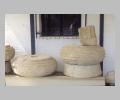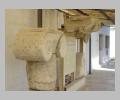| Context: | Metapontum |
| Type: | Temple |
| Summary: | Ionic temple situated at the north-east border of the religious sanctuary of the city. |
| Date: | ca. 475 BC |
| Dimensions: | The maximum dimensions of the foundations measure ca. 17.90 m. x 41.60 m. An axial mass for the temple of 14.75 m. x 38.40 m. is proposed. The excavators suggest that the island ionic/attic foot of 29.4 cm. was the unit of measurement used throughout, resulting in overall dimensions for the temple of 50 x 130 F. The maximum width of the cella building measures ca. 8.12 m. The column height is estimated at between 5.97 m. and 6.25 m., with a lower column diameter of 67.6 cm. - 70.8 cm. Thus, the proportion of lower column diameter:column height = 9:1. The relationship of the lower column diameter to the interaxial spacing is expressed in the proportion 1:3, resulting in a distance of ca. 2.0 m. - 2.10 m., or 6 7/8 F. The three central intercolumniations were widened at the facade to 7 9/16 F. |
| Region: | Lucania |
| Period: | Early Classical |
Architectural Order:
Ionic
Plan:
Very little is preserved of the temple in situ: the SW corner and parts of the southern and western foundations of the cella, and the lowest foundation block of the NW corner. However, the excavators suggest the following plan on the basis of a reconstruction of the dimensions of the foundations: the temple was peripteral, and was extremely long and narrow with the unusual number of 8 x 20 columns. The temple was pseudodipteral, with wide ptera. The cella building was very simple, consisting of a naos and elongated pronaos, with no columns in the pronaos, no antae, and neither opisthodomos nor adyton. The pronaos was not open for its entire width, but was apparently entered through a door, lending a megaron-like aspect to the cella building. There were no columns inside the cella. The cella building was aligned with the third column along the flanks of the peristasis.
Date Description:
The building period of the foundations cannot be later than ca. 475 B.C., based on ceramic evidence from the excavations. The style of the architectural moldings, for example the concave leaves of the palmettes in the frieze, accords with this date.
History:
Unlike the other major temples in the sanctuary at Metapontum, the Ionic temple had only one building phase, with the foundations, peristyle and cella built in smooth succession. The building was constructed towards the end of the first quarter of the fifth century B.C. Fragments of terracotta acroteria appear later in date, and indicate that restorations were carried out. Ceramic evidence indicates that the temple was destroyed in the third century B.C.; shortly thereafter, most of the stones were removed for reuse elsewhere, and the foundations were filled in with debris, including some of the architectural elements of the superstructure.
Other Notes:
The temple presents a number of unusual features. The combination of an architrave, molded frieze, dentils, geison and sima does not conform to the canonical Ionic system of epistyle, dentils, geison and sima prevalent at this time in Asia Minor. The elongation of the plan, and the pseudodipteral effect created by the narrow cella, at first appear to presage developments in Ionic temple architecture of the Hellenistic period, for example at the
Other Bibliography:





